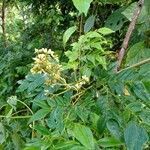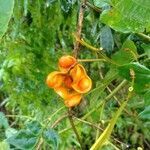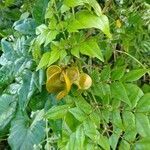Trees, to 10 m tall. Branchlets angulate, densely yellow tomentose. Leaf petiole 4-angulate; leaf rachis and base of petiole with glands; glands flat or hollow; pinnae (3 or)4 or 5(-8) pairs, densely yellow tomentose, lowermost pinna with 3-6 pairs of leaflets, uppermost one with 10-12 pairs of leaflets; leaflets subsessile, adaxially shiny, oblique, rhombic-trapezoid, 1-7 × 0.7-3 cm, upper one largest, downward smaller, leathery, both surfaces slightly brown pubescent, base very unequally sided. Corymbs several flowered, arranged in terminal or axillary panicles. Flowers pedicellate. Calyx campanulate, 1-3 mm, 5-toothed, calyx and corolla densely brown villous. Corolla white or yellowish, 4-5 mm; lobes lanceolate. Stamens ca. 2 × as long as corolla, staminal tube equaling corolla tube. Ovary stipitate, hairy. Legume twisted, 1-1.5 cm wide, margin constricted between seeds. Seeds 4-10, black, ellipsoidal or broadly ellipsoidal, ca. 1 cm; testa wrinkled when dry. Fl. Feb-Jun, fr. Apr-Aug.
More
A small tree. It grows 10-15 m tall. The trunk is straight and cylinder shaped and has grooves along it. The bark is smooth or with fine cracks. The small branches are angled. The leaves are twice divided and have a leaflet at the end. They leaves are 15-50 cm long. There are 3-10 pairs of pinnae 2-15 cm long with 3-10 pairs of leaflets on each. The fruit are pods 20 cm long by 1 cm wide. They are twisted into a spiral. They are red when mature.
A subcanopy tree of primary and secondary rain forest; swamp forest; evergreen forest on clayey or grey silt, laterite, sand, and limestone soils; dry deciduous Dipterocarp forest; upper mixed deciduous forest; at elevations up to 1,700 metres.
More
It is a tropical plant. It grows in rainforest and swamp forest. It grows up to 1,700 m above sea level.




